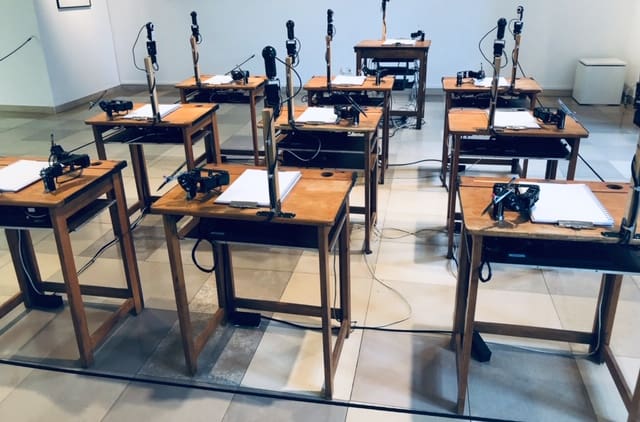Ars Electronica, a post-future, our present dystopia, a tech-infused art fair, a Burning Man with robots. Spanning a multitude of venues and attracting thousands of visitors annually to Linz, Austria, this art and tech event can’t be described in a tweet.

At once alienating and seductive, PostCity, a vast abandoned post office and the festival’s central headquarters, offered such an array of work it felt like a frantic global science fair. In contrast, Kultúr Quartier, the site for winners of the Prix Ars Electronica (claimed as the world’s most time-honored media arts competition), resembled a temple to the media artist and her holy intention. The festival brilliantly provided the synthesis with a third location, the St. Florian Monastery, outside Linz. With a day of music presented live, with and without technology, the monastery opened a space for a shared experience in real time.
The spattering of “workshops” at PostCity provided a deeper dive into a few of the thousands of ideas floating on the surfaces of screens and emanating from the speakers. Woman Reclaiming AI got into the weeds of AI, honing in on the tsunami waiting to happen if the current practices aren’t disrupted. Richard Euslig of ACIDS (Artificial Creative Intelligence and Data Science) lead a session that was basically Machine Learning for Dummies, illuminating the concepts of “filters”, “weights” and “back propagation” for those of us struggling to see behind the opaque curtain of AI and its tributaries. Most fortunately, Drew Hemment of Edinburgh Futures Institute’s Experiential AI illustrated the role artists can play in both humanizing and advancing technologies and brought some optimism to the concrete jungle of PostCity. Artists take heart! AI is a tool, and it’s up to us to determine its uses. AI left to its own devices or in the hands of a lesser practitioner almost always starts to sound like an old- fashioned broken record.
 Some of the more nuanced uses of technology were applied in the performances that filled the St. Florian Monastery. Tenebrae by composer Roberto Paci Dalò played exquisitely on solo bass clarinet in St. Florian’s sunlit drawing room, and Heavy Requiem which featured the chanting of Buddhist monk, Eizen Fujiwara, accompanied by responsive electronic sound (Keiichiro Shibuya) and large-scale media (Justine Emard) performed in the Basilika. The dynamism of these two live presentations–– shared in space and time with others––renewed my (our?) faith. Faith in homosapiens and our attempts to express our inner life and scrutinize our outer condition.
Some of the more nuanced uses of technology were applied in the performances that filled the St. Florian Monastery. Tenebrae by composer Roberto Paci Dalò played exquisitely on solo bass clarinet in St. Florian’s sunlit drawing room, and Heavy Requiem which featured the chanting of Buddhist monk, Eizen Fujiwara, accompanied by responsive electronic sound (Keiichiro Shibuya) and large-scale media (Justine Emard) performed in the Basilika. The dynamism of these two live presentations–– shared in space and time with others––renewed my (our?) faith. Faith in homosapiens and our attempts to express our inner life and scrutinize our outer condition.
What became clear over five days of Ars Electronica input is that the shared experience provides at least three treasures––relief from the flatness of tech (including VR which in its attempt to be 3D often feels flatter!), an assurance of one’s connective capability, and, at its best, a transcendance of it all. That’s why we do what we do at MAX: live with tech // līve with tech. Stay tuned for our upcoming workshop on you and your device––our first focus on the human-machine interface.

